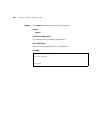F
GLOSSARY
Access Control List
(ACL)
ACLs can limit network traffic and restrict access to certain users or
devices by checking each packet for certain IP or MAC (i.e., Layer 2)
information.
Address Resolution
Protocol (ARP)
ARP converts between IP addresses and MAC (i.e., hardware) addresses.
ARP is used to locate the MAC address corresponding to a given IP
address. This allows the switch to use IP addresses for routing decisions
and the corresponding MAC addresses to forward packets from one
hop to the next.
Boot Protocol
(BOOTP)
BOOTP is used to provide bootup information for network devices,
including IP address information, the address of the TFTP server that
contains the devices system files, and the name of the boot file.
Class of Service (CoS) CoS is supported by prioritizing packets based on the required level of
service, and then placing them in the appropriate output queue. Data is
transmitted from the queues using weighted round-robin service to
enforce priority service and prevent blockage of lower-level queues.
Priority may be set according to the port default, the packet’s priority
bit (in the VLAN tag), TCP/UDP port number, IP Precedence bit, or DSCP
priority bit.
Differentiated
Services Code Point
Service (DSCP)
DSCP uses a six-bit tag to provide for up to 64 different forwarding
behaviors. Based on network policies, different kinds of traffic can be
marked for different kinds of forwarding. The DSCP bits are mapped to
the Class of Service categories, and then into the output queues.
Domain Name
Service (DNS)
A system used for translating host names for network nodes into IP
addresses.
Dynamic Host
Control Protocol
(DHCP)
Provides a framework for passing configuration information to hosts on
a TCP/IP network. DHCP is based on the Bootstrap Protocol (BOOTP),
adding the capability of automatic allocation of reusable network
addresses and additional configuration options.


















